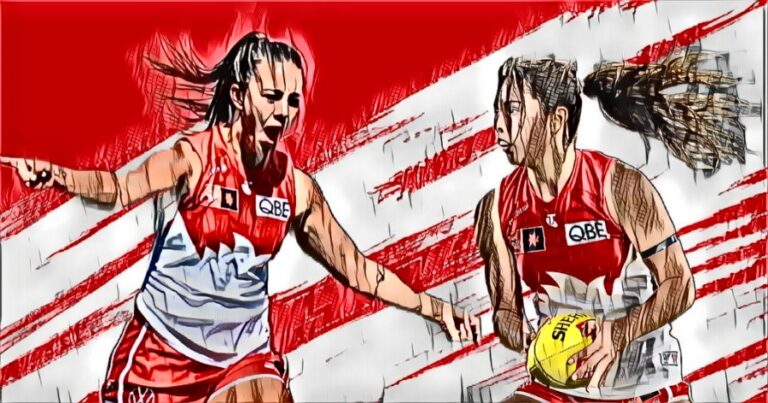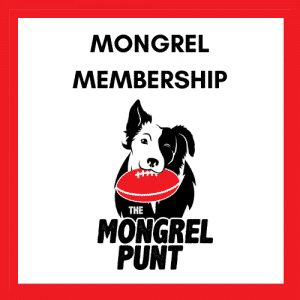As we head towards the final round of the 2023 AFLW home and away season, a few teams are still in contention to lock in the last three spots in the top eight.
Whoever wins on Friday night between Essendon and Gold Coast will lock themselves into potentially a double chance in the top four, or at the very least, will secure a home elimination final.
Then It comes down to three. Should the Suns lose, their fate lies in the hopes that Geelong, Sydney, St Kilda and Collingwood all lose their corresponding matches to stay in the hunt.
But let’s rewind it a little bit there. Sydney is in contention for finals footy; how many of us in the pre-season had that written down in the bingo card?
I certainly hadn’t. I think I had them down to winning a couple of games and seeing them as more of a competitive side than last year – let’s face it, an improvement on that season wouldn’t have been hard.
Their ten losses last year saw them average a losing margin of 37 points, an average of just under 21 points per game (including two matches that saw them go goalless) and concede an average of 57.7 points per game.
This year, however, they are the AFLW’s Cinderella story, from a winless first season to a record of 5-4 and knocking on the door of finals if they beat Fremantle at Fremantle Oval this weekend.
The turnaround in stats this year has proven to be something to behold. After nine games, they are fifth in the league for points scored, having averaged 46.8 points after nine games this season – a staggering 25-point increase from last season.
Defensively, they concede 46 points per game so far this season. Whilst it’s an improvement on last season, they are still in the bottom five in the competition in terms of points conceded.
But it goes to ask what’s changed in this side? Why is Sydney where they are and are just a game away from playing finals football after coming from such a long way back in season seven?
It’s no secret that many of Sydney’s successes this year come from their trio of big-name signings over the off-season. It’s something that they were crying out for last season, but they were unable to attract big names from rival clubs across the league.
But they eventually landed big fish in Chloe Molloy and Lucy McEvoy and showed how much they rated both players by naming them as the co-captains of the side heading into this season.
Without question, they’ve proven to be elite choices in leadership by both Scott Gowans and the playing group.
I know Carlton has copped a lot of flak for their lack of success the past couple of seasons, but Lucy McEvoy arrived at the club months after the Blues were in a Grand Final. They were a solid side in 2020 and good enough to compete for a finals spot in 2021 before things started going South.
So I don’t doubt she’s taken a lot of learnings from a team point of view and from an individual sense to apply that to the Swans camp. It’s been interesting, to say the least, seeing her hold down a spot as more of a defensive general.
But she’s averaging career-highs across the board: disposals (15.6 per game), metres gained (270.2), rebound 50s (3.8), intercept possessions (6.1), and contested marks (0.7). She’s had plenty of help around her in defence this season, but she’s been a key pillar.
Chloe Molloy’s last two weeks have seen her rise into being a consideration as a top-10 player of this season. We know that her best is box office stuff, but we’ve seen the past few years at Collingwood that it can fluctuate.
There’s been no denying that Molloy is back to her best this season. She’s spent much more time in the midfield this year, but we’re also seeing her be that scoreboard threat that made her such a dangerous player from her draft year.
Her 17 score involvements the other week against the Western Bulldogs smashed the previous record of 13, and it may be something that will take years to break, as that will not be done overnight.
As a mid-forward hybrid player, she’s averaging 17.1 disposals and 1.3 goals per game this season.
Only a few players in the competition are averaging over 15 disposals and a goal per game: Kate Hore averages 18 and two, and Bonnie Toogood averages 19 and 1.7 as high half-forwards. Sophie Conway averages 15.6 and 1.2 as a winger, and Zarlie Goldsworthy averages 18 and 1.2 as a mid-forward type.
Those sorts of players don’t grow on trees, and while the game continues to grow in scoring and star power, those sorts of players who can win the ball and provide a scoreboard impact are still worth their weight in gold and then some.
But it’s also remiss not to mention what Laura Gardiner has added to this Sydney side, either. Whereas Molloy is the player that has tricks coming out of all angles, Gardiner is the player that has the grunt, the work rate and the skill to win the ball, weave out of congestion and realistically, get the ball rolling for her teammates so they can get in the best position to score.
At Geelong, she was starved of this opportunity to be an elite midfielder because they were already stocked for talent in this area. At Sydney, there wasn’t anyone there who could win the ball so quickly.
Last year, the number one disposal getter (on average) was Montana Ham, who missed a few games due to a knee injury and was playing a reduced role upon her return anyway.
This year, Gardiner averages 29.1 disposals per game and is just over 11 disposals per game, up on the next best player. She also averages 5.9 clearances, leading all Swans in the category, and defensively, she proves her worth also, averaging 9.3 tackles per game.
These three bring something unique to the plate at Sydney, and they’ve all added so much to the rest of the playing group.
This leads towards those who played in the side last year, who’ve taken a giant leap in their development.
The first and most apparent is Ally Morphett. She has missed the last two games and will most likely miss this week. She has been considered one of the front-runners for the league’s Rising Star Award.
This time last year, she was on the fringes of Sydney’s side but has come back emerging fitter, more vigorous, more skilled and athletic around the ground, which essentially passes her off as another midfielder.
Morphett averages 29.3 hitouts, 17.9 disposals (second at the club), 5.1 clearances (also second at the club), 3.3 marks and 12 contested possessions per game.
Rebecca Privitelli is another I consider a big improver. She was solid despite the Swans’ limited supply in the forward line last year. Still, given the improvement in inside 50 generations this season, she’s produced a career-best season in terms of scoring output: 13.6 for the season, as well as averaging 3.9 score involvements for the year – are both personal bests.
She’s also getting hands to the ball more aerially and at ground level: 4.1 marks per game and 10.9 disposals are career-high numbers. Her contested marking numbers are at 1.2 per game, the highest since 2020 when she averaged nearly two per game.
One that might not get as much recognition as the others is the intercept game of Ella Heads in defence.
I know my good mate and colleague Alex Catalano has high praise whenever we mention her name on the A3 Footy Podcast. Still, when you see her live, you get a genuine appreciation for how she positions herself among Sydney’s defensive press and her ability to properly impact contests, either by intercept marking or a force to kill the contest and reset the Swans system.
Heads is someone I can see already emerging as a young leader. She averages four intercept possessions per game, sitting behind three other players, but she also averages 4.6 marks per game (first at the Swans), which tells me she’s one of the players who helps set the pace in which the Swans want to move the ball.
Sometimes, it’s been a slingshot style of offence. Other times, it has been methodical and attempting to work through defences.
Naturally, we work through to the young kids of the team. I’m talking about the likes of Montana Ham, Cynthia Hamilton and Sofia Hurley.
Ham has been in and out with injury, although her past month has shown exactly why she was rated as a top-three talent last year. She has good size, she’s got good marking hands, she can extract in the middle, she can score up forward. She’s got the potential to be a generational talent.
The problem is that injury has hampered both this season and last. If she can have a fit pre-season and translate that on the field, the competition better looks out.
Hurley’s last month has seen her average 18.2 disposals, seven tackles, 2.7 clearances, 3.2 score involvements and has kicked two goals in each of her past two games. She’s excelling as a half-forward type who can work well in the stoppages; it’ll be a matter of time before we see her play full-time in the midfield.
And while Hamilton’s numbers have stagnated a fair bit, there’s some leeway we can give. She has spent much more time in the forward half this season than being a more prominent fixture in the midfield.
In season seven, she was the third-highest midfielder in attending centre-bounce stoppages, averaging 40 per cent. That has gone down to just 14 per cent this year, as players like Molloy, Gardiner, and even Tanya Kennedy have seen more minutes as a midfield run-with player.
But, we have seen lifts in her scoreboard impact, kicking 6.8 for the season and four goal assists on an average of 3.4 score involvements per game. There’s still scope for her to be a player that can average 15 disposals and a goal per game down the road, but in the meantime, she’s a player that will take some time to get there.
Many other players deserve their flowers this season at the Swans.
Bella Smith for her versatility. She has been playing ruck the past few weeks but has also floated between key forward and key back across the past couple of seasons.
Brenna Tarrant for being the full back of the side, battling away at the opposition’s best key forward every week.
Alana Woodward for being the back pocket player tasked with taking on some of the league’s better small forwards.
Tanya Kennedy for coming into this team this season and matching up with some of the league’s best midfielders around stoppages.
Regardless of the result on the weekend, the Swans have been one of the league’s biggest improvers. Irrespective of whether they play finals this year, they’ve got a significant foundation set that should take them up the ladder in the following years.
The Doc is the heart and soul of our AFLW coverage. He pours himself into it to provide the best in the business. If you come here for AFLW stuff and enjoy what he does, please consider buying him a coffee for the work he does by clicking the link below. I’m sure he’d greatly appreciate it.



